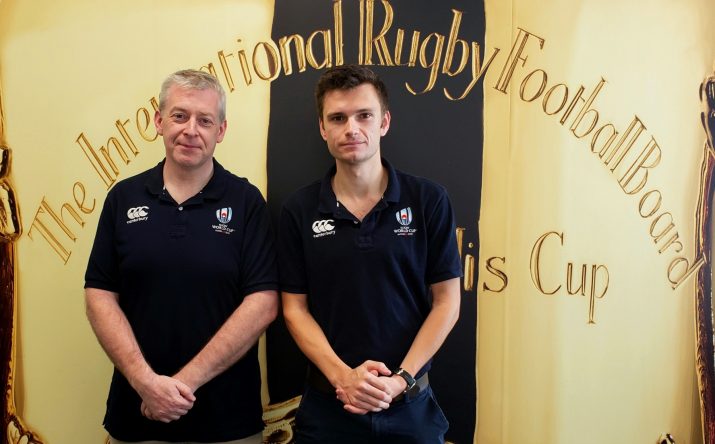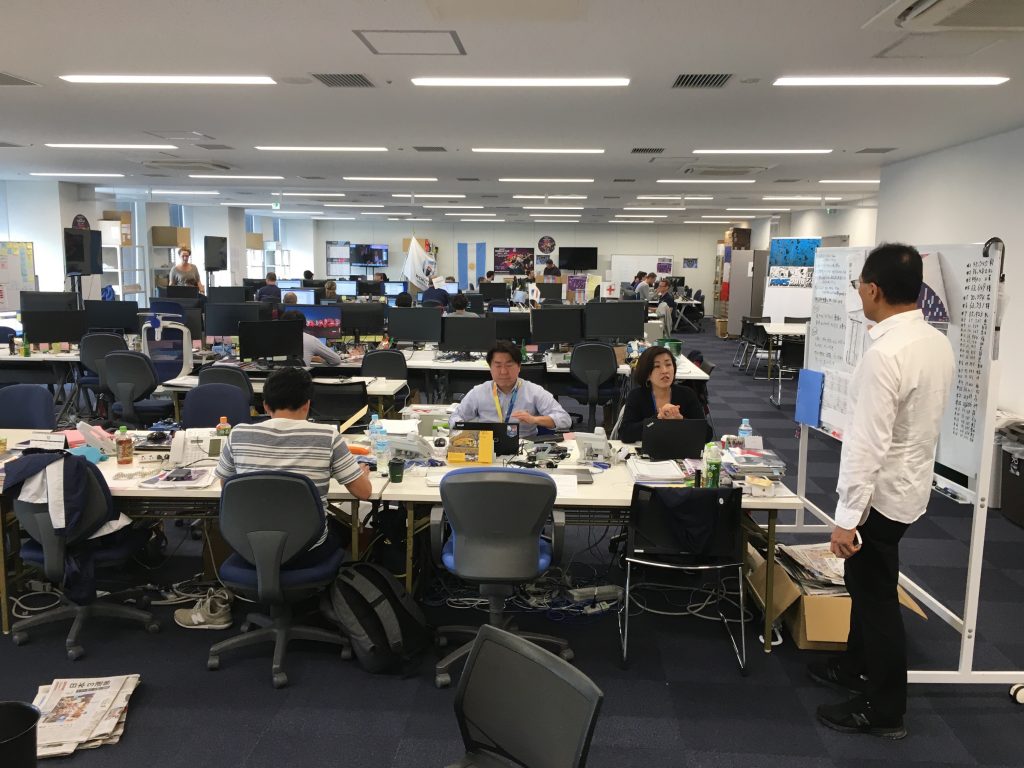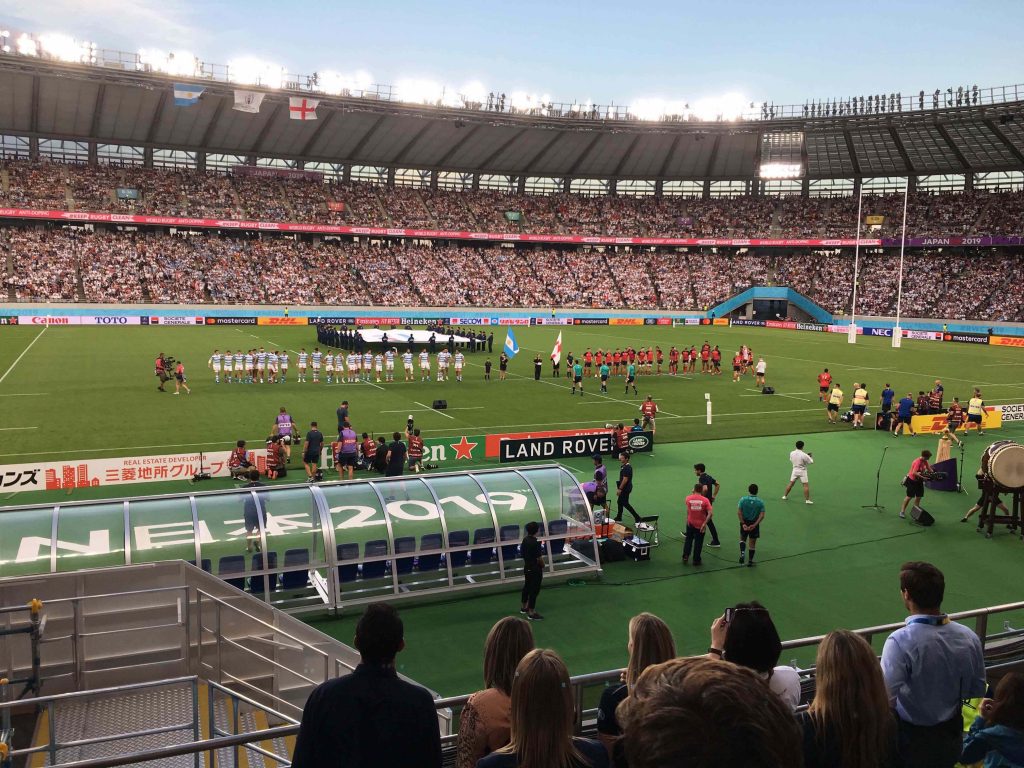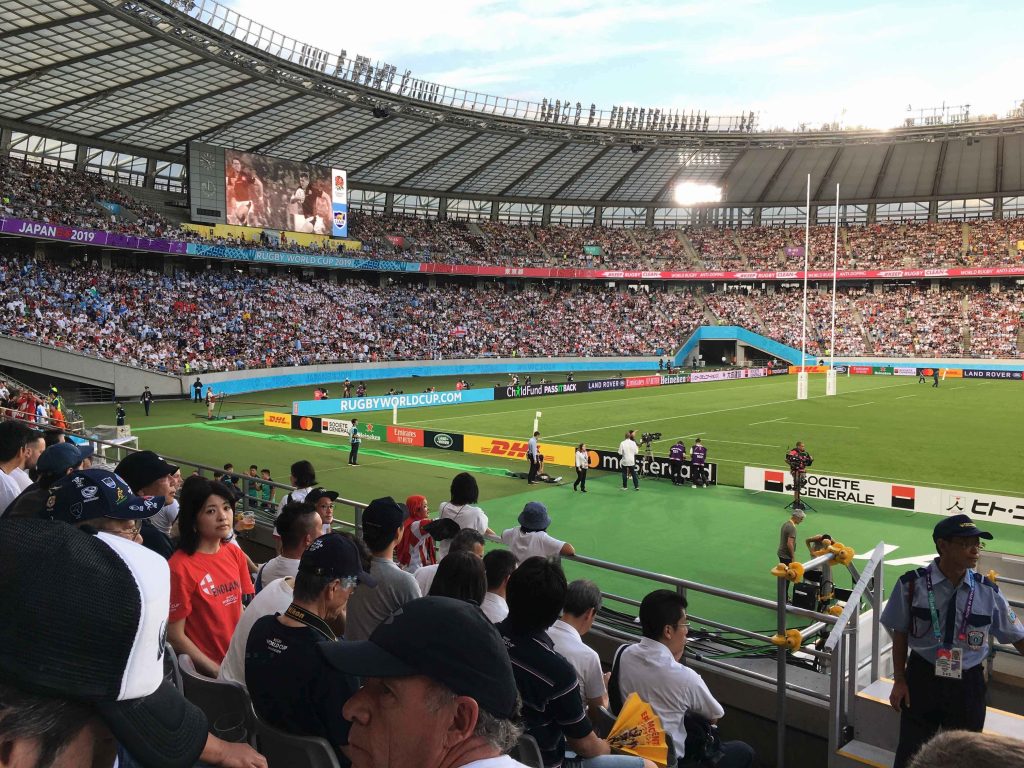Live from the Rugby World Cup: Content production integration extends tournament reach for World Rugby

Ronan Donagher, World Rugby (left) and James Barton, Hawk-Eye Innovations
Headquartered in Dublin, World Rugby is comprised of 103 national member unions and 18 associate unions from the game’s six regional associations. World Rugby’s mission is to continue growing the rugby family and build a global mass-participation sport.
Under the control of World Rugby are the Women’s Rugby World Cup, Rugby World Cup Sevens, HSBC World Rugby Sevens Series, World Rugby U20 Championship, World Rugby U20 Trophy and the World Rugby Pacific Nations Cup. The principal World Rugby property is, however, Rugby World Cup (RWC).
At the tournament head office in central Tokyo SVG Europe sat down with World Rugby IT and broadcast manager Ronan Donagher, along with Hawk-Eye Innovations Director of SMART Sports James Barton, to talk about content production for the tournament and some of the working relationships that have been put in place for 2019.
Some key suppliers are Alston Elliot, Great Big Events, Hawk-Eye, Opta and Sound Sure, and it is clear from the integration of the content output and ecosystem – along with the IGBS host broadcast piece provided by the HBS and IMG Media joint venture – that 2019 is a radical departure from previous RWC tournaments in terms of content production workflows and output.
For the first time at a Rugby World Cup, all 48 matches are being produced in multiple formats, with UHD/SDR, 1080p and 1080i available. As well as the traditional World Feed, rights holding broadcasters have access to additional uninterrupted live feeds to complement their studio coverage.
Dedicated RWC ENG crews provide content from around the country, and a dedicated post production team is producing a variety of features and magazine shows.
All live and ENG content is available via the World Rugby Media Server, and new

View of social media teams producing content at World Rugby Tokyo HQ for the Rugby World Cup
for 2019 is the Match Day Preview Show. World Rugby is also producing specific content to help promote the event on a variety of social media platforms, with short form graphics, info graphics and 360 VR clips available for the first time.
“Design agency Ignite delivered the graphics design for titles and in-match graphics, through a tender process. Alston Elliott and Opta are delivering the Tournament Information Services (TIS), which encompasses the stats collection and delivery of onscreen graphics,” Donagher told SVG Europe.
“We started working with Hawk-Eye back in 2014, for the 2015 tournament. The relationship has moved on a lot from where it started, which was primarily focused on player welfare. Medical was the initial driver to embrace an independent video replay solution in rugby, for Head Injury Assessment (HIA).
“For the same tournament we also took in player citing, TMO [Television Match Official] and in addition to the above Hawk-Eye encode and provide a number of different feeds to the teams and other stakeholders. This footage is key to the analysis of the game for the teams and likewise for the match officials who use it to review the performance of all officials including the TMO via the TMO cam.
“While providing all those services again, we have refined and enhanced how these services are delivered. If you just look at the citing aspect, it’s not just about supplying files to the citing commissioners any more. It’s actually about sitting with them and really being their assistant – and producing the output that’s needed for a player hearing,” said Donagher.
The storage and onward distribution of this footage utilises a number of different systems including Signiant as the primary storage and delivery mechanism. All this footage is offloaded in real-time to a different cloud storage application, which serves as a backup to the original location in the event of a failure but also as a collection point for the RWC digital media team who use this footage in the creation of their short form content and social media output.
“Every broadcast angle is ingested centrally with seven servers writing to circular buffers providing around eight hours of match footage at any given time. That is all captured during the game, and there is live access to that from each of the clients in the venue. It’s all synchronised on ingest.”
Parallel to this the footage is also offloaded to the RWC AMS (Athlete Management System) which is used in the management of the match officials.
“Whistle to whistle, we provide full match exports of camera ISOs (TX and seven different camera angles). Seven of those ISOs go straight to the teams so they can do their analysis,” said James Barton.
“In-venue they get live HD-SDI feeds, so that they are coding things in-game, enabling them to use that information at half time. Post-match, every team gets access to all of the footage, so you don’t have to be in-venue to get footage of the team you will be playing in two weeks.
“We integrate heavily with [host broadcaster] IGBS,” said Barton. “In venue we have kits that essentially follow their technical units. We have a Video Operations Room (VOR) cabin in the OB compound, with a rack of our seven SMART Replay servers. This is the IP-based video replay backbone that now drives the vast majority of Hawk-Eye services.
“Every broadcast angle is ingested centrally with seven servers writing to circular buffers providing around eight hours of match footage at any given time. That is all captured during the game, and there is live access to that from each of the clients in the venue. It’s all synchronised on ingest.
“For TMO you have the Television Match Official from World Rugby in a cabin alongside two of our operators. The main review operator is responsible for putting the right replay in front of the TMO when they need it, and then we have a spotter who is responsible for ‘the best of the rest’ to ensure we don’t miss say a handheld camera that has the best angle of an incident. The spotter also communicates with TV, taking their cue and making sure the right vision goes to Big Screen and the World Feed.
“We have nine technical crews and nine kits in Japan, with two of our people travelling with each kits, including a technical guarantee engineer who is managing the site-wide operation. And for medical we’ve got an operator pitch side with the match-day doctor, identifying a head injury or a potential head injury as well as a second operator in the Medical Room pushing additional angles,” said Barton.
“We then have four teams of two who travel with the TMOs – so it’s essentially the equivalent of a technical versus a production crew. In 2015 our crews travelled with the TV directors, whereas here they travel with the TMOs – as we felt this is the most important relationship. That relationship is really working and has got us to the stage where the process has become much more efficient.
“It’s all based on shared bookmarking across the system. I can identify a point of interest for a medical incident and then the guys inside can immediately jump to the cameras so they’re seeing exactly what I’m seeing, and they can start looking for better evidence for it and can get that to other medics or team doctors,” said Barton.
“In other words they are not relying on getting a timecode transmitted to them verbally and looking across the different angles,” added Donagher. “Before having this system in place, the doctors were following the broadcast footage. While the director is telling the story to the TV audience the medical professionals require something different.
“For this tournament we’ve introduced picture-in-picture for TMO decisions; we can see the world feed, the referee and the TMO station” – James Barton
“This gives them independence; they’re not relying on directors, producers, cameramen or EVS co-ords. And the citing commissioners use a parallel workflow, using the exact same technology.
“But the key is that they’re looking for different things. The medical guys are purely focused on the medical stuff; the citing guys focused on the citing; and the TMO on his area – but they have the ability to interact as well.
“In addition to the video replay solution running over IP they have their own audio IP comms sitting on the SMART solution. So, everything is all in one, but there is backup like talkback in key places like the TMO station, just in case.
“And if everything goes wrong, the TMO can watch the world feed with guaranteed comms so they can still talk to the pitch and request angles from the EVS co-ord,” said Donagher.
“For this tournament we’ve introduced picture-in-picture for TMO decisions; we can see the world feed, the referee, and the TMO station,” added Barton. “You can see there’s a conversation going on between the referee and the TMO.
“The main benefit of this new framework approach is that, as an official, you’re also explaining your thoughts and educating the viewer, including your justifications and whether there were any mitigating circumstances before for example issuing a card,” he said.

Teams line up for Argentina vs England at Tokyo Stadium, Saturday 5 October
SVG Europe: Talk us through some of the other elements and partners that feed into the match-day production workflow.
“We have ENG crews out on-site. We’ve also put a media person with every team, which gives us a heads-up with what’s happening around the teams,” said Donagher.
“That helps us with content, but also with player registration and team sheets – which feeds into the citing, medical, TMO, broadcast, and social media. Opta are a key part of the whole process. Before the tournament even starts the teams contact the local organising committee and log their long list of players into our tournament management system.
“We perform the bio-matching process with our internal system and with Opta, if there are any mismatches we send it back to the team to verify the correct identity of a player. That’s key to the player stats – how many caps, how many tries and so on for each player.
“Opta record the statistics and these are made available in real time to Alston Elliot for gfx, Great Big Events for the sports presentation element of the event and of course the media who are key in the successful delivery of the RWC. The teams give us their actual list nearer the tournament, and 49 hours before a match they have to submit their team sheet.
“Opta then has that information which pushes into the graphics for Alston Elliot for the TV broadcast and pushes into our fixtures and results database, which in turn pushes onto our web site and app and plethora of social media.
“The back-up to that is that Alston Elliot can pull those stats from Opta rather than it being pushed. And in addition, AE record the primary stats on-site. If the primary method of stats communication were to become unavailable, they could take tries, penalties, conversions, player substitutions themselves in-venue.
“IGBS take a feed from Opta as well for their logging, so instead of doing all logging manually for highlights etc. they are taken in from Opta and married up with the video to tell them when certain things are happening.
“Hawk-Eye also provide a solution for Opta and to WorldRugby, for our referees and citing commissioners to watch footage from any location. They can watch the transmission and/or the wide angle and the high behind.
“This is our first major event in Asia. We wanted to get it right, and to control the product from start to finish” – Ronan Donagher
“Opta, back at their base in Leeds, are accessing that solution across the DAZN network back into Tokyo, and then they’re on our Tournament Information System. Hawk-Eye ingests the video feeds and provides the video content back into Leeds.
“This is the first time we’ve provided the footage, not on-site. The referees and citing commissioners can watch the three angles they want from any location, with ref comms built in – no commentary, just the ref comms.
“The citing commissioners and referees can’t go to every venue and are based at the IBC – but now also have this functionality so that they can watch in their hotel,” said Donagher.

Argentina vs England at Tokyo Stadium, Saturday 5 October
SVG Europe: In 2015 ITV was the host broadcaster for RWC in England. Through the operation of current host broadcast provider IGBS and all the additional content produced, World Rugby has come a long way from that ‘legacy’ scenario. Can you explain your thinking along this journey?
“We wanted to take control ourselves, as a governing body. We wanted to take control of the broadcast and the product – and make it a world feed product. We wanted an international approach,” said Donagher.
“This is our first major event in Asia. We wanted to get it right, and to control the product from start to finish. That’s primarily why we took the step. We went to tender, and three very good companies came in, with IGBS being successful in securing the contract. They have delivered solutions that have added to the overall production and have been welcomed by our rightsholders, including the Additional Content Feed, the Multi Feeds, the Rugby Interface (TRI), and the SCOOPA interface for social media.
“Our digital team downstairs in this building are taking a lot of stuff from the TRI and the SCOOPA server for their social media content. As a rights holding broadcaster you can sign up for the TRI and/or SCOOPA.
“The one thing we haven’t mentioned is the Ref Comms, which are organised and paid for by the local organising committee. They do that as part of the match management. The service provider there is a South African company called Sound Sure” said Donagher.
“They do a lot of work for us – all of the Sevens and they will be at the Olympics next year. What Sound Sure have also done is created an app and we’ve provided all the media, so the media personnel sitting in the tribune – or sitting anywhere in the world, in fact – can listen to what the referee is saying. That’s a first.”
